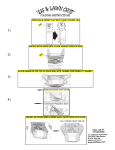Download Installation Information
Transcript
b) Page 1 GENERAL INFORMATION AND INSTALLATION A. INTRODUCTION These Cubers are quality designed, engineered and manufactured. Their ice making systems are thoroughly tested providing the utmost in flexibility to fit the needs of a particular user. These icemakers have been engineered to our own rigid safety and performence standards. NOTE. To retain the safety and performance built into this icemaker, it is important that installation and maintenance be conducted in the manner outlined in this manual. B. 8. Remove the manufacturer’s registration card from the inside of the User Manual and fillin all parts including: Model and Serial Number taken from the data plate. Forward the completed self-addressed registration card to the factory. UNPACKING AND INSPECTION 1. Visually inspect the exterior of the packing and skid. Any severe damage noted should be reported to the delivering carrier and a concealed damage claim form filled in subjet to inspection of the contents with the carrier’s representative present. 2. a) Cut and remove the plastic strip securing the carton box to the skid. b) Cut open the top of the carton and remove the polystyre protection sheet. c) Pull out the polystyre posts from the corners and then remove the carton. 3. Remove the front and the rear panels of the unit and inspect for any concealed damage. Notify carrier of your claim for the concealed damage as steted in step 1 above. C. LOCATION AND LEVELLING WARNING. This Ice Cuber is designed for indoor installation only. Extended periods of operation at temperatures exceeding the following limitations will constitute misuse under the terms of the Manufacturer’s Limited Warranty resulting in LOSS of warranty coverage. 1. Position the unit in the selected permanent location. Criteria for selection of location include: a) Minimum room temperature 10°C and maximum room temperature 43°C. b) Water inlet temperatures: minimum 5°C and maximum 35°C. c) Well ventilated location for air cooled models. Clean the air cooled condenser at frequent intervals. d) Service access: adequate space must be left for all service connections through the rear of the ice maker. A minimum clearance of 15 cm (6") must be left at the sides of the unit for routing cooling air drawn into and exhausted out of the compartment to maintain proper condensing operation of air cooled models. NOTE. With the unit in “built-in” conditions, the ice production is gradually reduced in respect to the levels shown in the graph. 4. Remove all internal support packing and masking tape. The daily ice-making capacity is directly related to the condenser air inlet temperature, water temperature and age of the machine. 5. Check that refrigerant lines do not rub against or touch other lines or surfaces, and that the fan blade moves freely. To keep your CUBER at peak performance levels, periodic maintenance checks must be carried out as indicated on Cleaning Section of this manual. 6. Use clean damp cloth to wipe the surfaces inside the storage bin and the outside of the cabinet. 2. Level the unit in both the left to right and front to rear directions. 7. See data plate on the rear side of the unit and check that local main voltage corresponds with the voltage specified on it. D. CAUTION. Incorrect voltage supplied to the icemaker will void your parts replacement program. ELECTRICAL CONNECTIONS See data plate for current requirements to determine wire size to be used on electrical connections. All icemakers require a solid earth wire. Page 2 The ice machines are supplied from the factory completely pre-wired and require only electrical power connections to wire cord provided on the back of the unit. Make sure that the ice machine is connected to its own circuit and individually fused (see data plate for fuse size). The maximum allowable voltage variation should not exceed -10% and +10% of the data plate rating. Low voltage can cause faulty functioning and may be responsible for serious damage to the overload switch and motor windings. NOTE. All external wiring should conform to national, state and local standards and regulations. Check voltage on the line and the ice maker’s data plate before connecting the unit. E. WATER SUPPLY AND DRAIN CONNECTIONS General When choosing the water supply for the ice cuber consideration should be given to: a) Length of run b) Water clarity and purity c) Adequate water supply pressure Since water is the most important single ingredient in producting ice you cannot emphasize too much the three items listed above. Low water pressure, below 1 bar may cause malfunction of the ice maker unit. Water containing excessive minerals will tend to produce cloudy coloured ice cubes, plus scale built-up on parts of the water system. Water supply Connect the 3/4" male fitting of the solenoid water inlet valve, using the flexible tubing supplied, to the cold water supply line with regular plumbing fitting and a shut-off valve installed in an accessible position between the water supply line and the unit. Water drain The recommended drain tube is a plastic or flexible tube with 18 mm (3/4") I.D. runs to an open trapped and vented drain. When the drain is a long run, allow 3 cm pitch per meter (1/4" pitch per foot). On water cooled versions, the water drain line from the condenser is internally connected with the drain fitting of the unit. A vertical open vent, at the unit drain connection, is also required for proper sump drainage. NOTE. The water supply and the water drain must be installed to conform with the local code. In some case a licensed plumber and/ or a plumbing permit is required. Page 3 F. FINAL CHECK LIST 1 bar (14 psi). 1. Is the unit in a room where ambient temperatures are within a minimum of 10°C even in winter months? 2. Is there at least a 15 cm (6") clearance around the unit for proper air circulation? 3. 8. Have the bin liner and cabinet been wiped clean? 9. Has the owner/user been given the User Manual and been instructed on the importance of periodic maintenance checks? Is the unit level? (IMPORTANT) 4. Have all the electrical and plumbing connections been made, and is the water supply shut-off valve open? 5. Has the voltage been tested and checked against the data plate rating? 6. Has the water supply pressure been checked to ensure a water pressure of at least G. 7. Check all refrigerant lines and conduit lines to guard against vibrations and possible failure. 10. Has the Manufacturer’s registration card been filled in properly? Check for correct model and serial number against the serial plate and mail the registration card to the factory. 11. Has the owner been given the name and the phone number of the authorized Service Agency serving him? INSTALLATION PRACTICE 1. Hand shut-off valve 2. Water filter 3. Water supply line (flexible hose) 4. 3/4" male fitting 5. Vented drain 6. Open trapped vented drain 7. Drain fitting 8. Main switch 9. Power line WARNING. This icemaker is not designed for outdoor installation and will not function in ambient temperatures below 10°C or above 43°C. This icemaker will malfunction with water temperatures below 5°C or above 35°C.




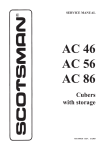
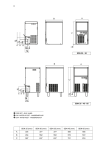
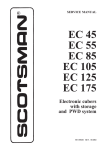

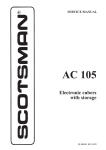
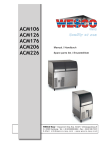
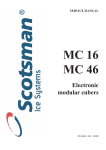
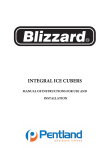
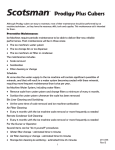
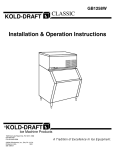

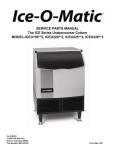

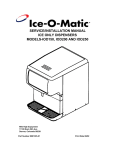
![Ice-O-Matic Service/Installation Manual [ 057899 ]](http://vs1.manualzilla.com/store/data/006005219_1-c31ed1ac0d7546c1a9e7f35925503107-150x150.png)
